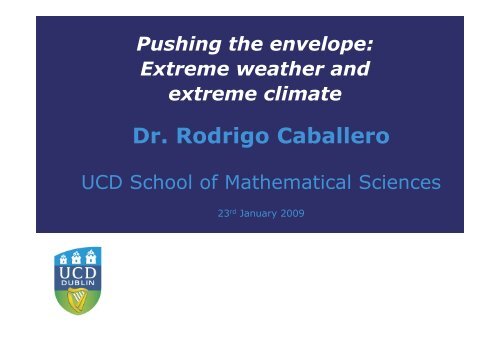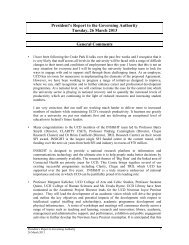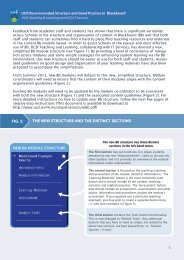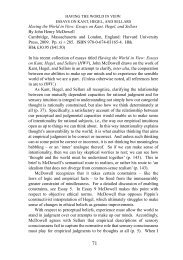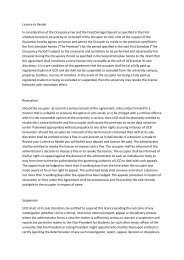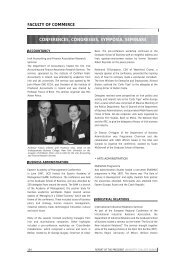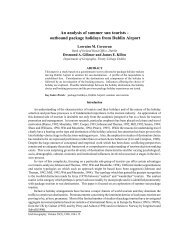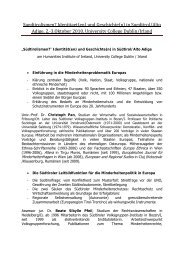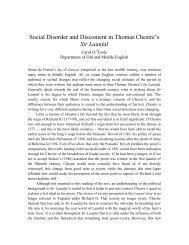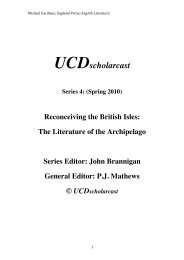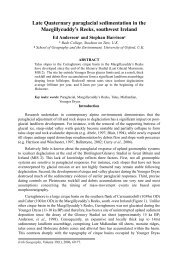Dr. Rodrigo Caballero
Dr. Rodrigo Caballero
Dr. Rodrigo Caballero
Create successful ePaper yourself
Turn your PDF publications into a flip-book with our unique Google optimized e-Paper software.
Pushing the envelope:<br />
Extreme weather and<br />
extreme climate<br />
<strong>Dr</strong>. <strong>Rodrigo</strong> <strong>Caballero</strong><br />
UCD School of Mathematical Sciences<br />
23 rd January 2009
UCD Earth Systems Institute<br />
Meeting the Challenge of Climate Change<br />
Seminar Series<br />
In collaboration with<br />
Comhar Sustainable Development Council, Environmental<br />
Protection Agency, Forfás, Geological Survey of Ireland,<br />
Met Éireann, Sustainable Energy Ireland & Teagasc<br />
Further details on the seminar series is available at www.ucd.ie/earth<br />
A paper and podcast of this seminar will be available on the ESI website<br />
soon, please join the online ESI mailing list for such notifications<br />
ESI email: esi.admin@ucd.ie
The world is getting richer, faster<br />
World per-capita GDP (1990 international dollars)<br />
year<br />
(Source: B. DeLong, www.j-bradford-delong.net/TCEH/1998_<strong>Dr</strong>aft/World_GDP/Estimating_World_GDP.html)
The poor are catching up<br />
World per-capita GDP (1990 international dollars)<br />
year<br />
(Source: A. Maddison, www.ggdc.net/maddison)
9<br />
World<br />
Population<br />
(billion)<br />
The ‘Great Transition’<br />
6<br />
The present<br />
7,000 21,000<br />
World Income Per Capita ($)<br />
The future?
All this growth has been powered by<br />
fossil fuels<br />
Atmospheric carbon dioxide concentration over time
The Challenge, part I<br />
• Target future is unsustainable with current<br />
technology<br />
• Would burn through all known fossil fuel reserves<br />
in about 100 years<br />
• Achieving a globally wealthy long-term future<br />
necessitates a fundamental change in the way we<br />
produce and use energy
The Challenge, part II<br />
• Elevated CO 2 levels may lead to dangerous<br />
climate change<br />
• But we need to continue emitting CO 2 while we<br />
develop and adopt new technologies<br />
• So how much CO 2 can we emit without running<br />
significant risks?
Avoiding dangerous climate change<br />
• This is a problem in risk assessment<br />
• Need a tool that accurately determines the<br />
climate impact of a given CO 2 level<br />
• The only available tool are climate models<br />
• But these remain a somewhat blunt tool, subject<br />
to important uncertainties<br />
(P. Raskin et al., Great Transition, 2002)
What is a climate model?<br />
At heart, a climate model is a set of mathematical<br />
equations the give the rate of change of wind,<br />
temperature etc. For the atmosphere:
What is a climate model?<br />
Need to solve the equations on a grid, using a computer
How good are the models?<br />
Models are coming increasingly closer to<br />
observations<br />
LEVEL OF AGREEMENT WITH OBSERVATIONS:<br />
perfect good<br />
bad<br />
1995<br />
2001<br />
2007<br />
(Reichler & Kim, BAMS 2007)
Models reproduce recent climate change<br />
only if anthropogenic CO 2 is included<br />
(Anthropogenic = emitted by human activities)<br />
Observed<br />
Simulations with<br />
anthropogenic<br />
forcing<br />
Same<br />
simulations but<br />
without<br />
anthropogenic<br />
forcing<br />
(IPCC AR4, 2007)
Extreme climates
The Eocene<br />
The Eocene (50 million years ago) was much warmer<br />
than today<br />
surface temperature ( o C)<br />
Now<br />
Eocene<br />
(Greenwood&Wing, Geology 2001)
Northern Canada today
Northern Canada 50 million years ago
How did it get so hot?<br />
CO 2 was a lot higher, for one thing<br />
Eocene<br />
Today<br />
(Fletcher et al., Nature Geo 2007)
The ‘low-gradient paradox’<br />
A major unsolved problem<br />
Eocene simulations<br />
using 500—2000 ppm CO 2<br />
Eocene data<br />
20 o C mismatch!<br />
(Shellito et al. 2003)
Possible implications for future climate
What is wrong?<br />
No-one really knows, but here’s the hypothesis we<br />
are exploring in ongoing work:<br />
• Poles kept warm by atmospheric heat transport<br />
• Most transport associated with fronts<br />
• Fronts not properly resolved<br />
• Problem not noticeable in current climate, but is<br />
exponentially amplified as temperature increases
The atmospheric circulation
Extreme storms
Simulating extreme storms<br />
• Extreme storms highly sensitive to resolution<br />
• Basic physics not fully understood<br />
Observations<br />
Lothar simulation<br />
with 30 km resolution<br />
(Wernli et al., QJRSM 2002)
How will extremes change in future?<br />
• There is evidence that extremes may become<br />
more frequent in a warmer climate<br />
• But extremes are by definition rare<br />
• To assess changes in once-a-century storms,<br />
need to simulate several centuries<br />
• Also need high resolution<br />
• Very computationally demanding!
The 1000 year run<br />
• We are currently conducting a 1000-year highresolution<br />
run to assess changes in extreme<br />
windstorms over Europe<br />
• First of its kind<br />
• Working with partners in the insurance industry<br />
to assess how these changes may impact<br />
property exposure
Extreme computing
The computational challenge<br />
• With current technology, climate simulations<br />
limited to about 30 km resolution<br />
• Would like to run at 1 km resolution<br />
• Requires 10,000-fold increase in computer power
The computational challenge<br />
• By Moore’s law, this would<br />
take 20 years — too long!<br />
• Need to beat Moore’s Law<br />
to adequately address<br />
climate change uncertainty<br />
• Requires much smarter use<br />
of current technology /<br />
changeover to new<br />
technology
What role for Ireland?<br />
• The ‘great transition’ to a wealthy and<br />
sustainable future will be a knowledge-intensive<br />
process<br />
• It will be a fluid period of change and innovation<br />
• Small players who take the initiative can punch<br />
above their weight
What role for Ireland?<br />
• Seizing these opportunities will require continued<br />
investment in strategic areas, amongst which:<br />
– Basic climate research (reducing uncertainty)<br />
– Computer technology (beating Moore’s Law)<br />
– Weather and climate risk assessment<br />
– ‘Green finance’<br />
– Alternative energy<br />
• Ireland is well positioned to develop strong<br />
capabilities in all these areas<br />
• Facilitating such development is a key aim of the<br />
UCD Earth Systems Institute


